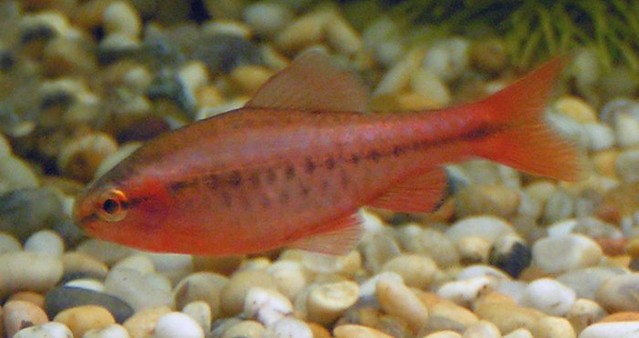 |
| Cherry Barb - Photo by lakpuratravels |
Cherry barbs received their name because of their bright red color palette. They are a small, elongated fish only reaching a length of approximately two inches when fully grown. Typically, the upper part of their bodies leans toward a greenish shade with a slight sheen. A racing stripe that varies from a brownish color to bluish black runs from the tip of their snouts down the entire length of their bodies. Above the stripe is an iridescent band that is generally gold at the front part of their bodies and fades toward blue or green towards the tail. The males are redder than the females. But they do not develop the bright, cherry red coloration they are named for until they enter the spawning cycle. The cherry color is not found among the females of the species. Females are lighter in color and have yellow fins. The female's body tends to be a lot plumper than the males.
Cherry barbs make good community tank fish provided they are housed with fish that are not large enough to view them as a tasty snack. They are shoaling fish that take readily to heavily planted aquariums. Since they travel in schools in their natural habitat, it is advisable to add multiple barbs to your fish tank rather than a single fish. While cherry barbs do enjoy the company of their own species, they do not congregate as tightly as most barbs or tetras. It is, in fact, not uncommon to see a single barb venture away from the pack.
They are originally from Sri Lanka. Lake Sir Lanka is an island country in southern Asia located off the southern coast of India. Cherry barbs prefer soft, slightly acidic water with a temperature variance between 72-79 °F.
Cherry barbs are omnivores. They can be fed common tropical fish flakes as their primary diet.
Breeding Cherry Barbs
Cherry barbs breed in captivity. This is a good thing. Their numbers have decreased drastically in Sri Lanka.
Feeding barbs frozen or live meaty foods such as brine shrimp will help to induce the spawning cycle. The male, as mentioned earlier, will develop a bright cherry color when ready to spawn.
Once the male displays his spawning colors, the barbs should be placed in a breeding tank. Barbs scatter their eggs. Like most egg scattering fish, cherry barbs will eat their un-hatched eggs. A good breeding trick is to place marbles in the bottom of the breeding tank. The eggs will slip down in between the marbles and prevent the parents from being able to get at them. After spawning, the adult barbs should be removed from the breeding tank.
The fry will hatch in about 24 hours. The fry can be feed liquid fish fry food developed for egg laying fish. In a couple of days switch their diet to newly hatched brine shrimp or small amounts of powdered eggs. When they reach a week or two in age you can feed them finely crushed tropical fish flakes.
By Stephen J Broy Many home aquarium owners cringe at the thought of maintaining a saltwater aquarium. What most of them don't realize is that a Jellyfish Fish Tank Aquarium requires little more maintenance than a freshwater tank. Keeping Pet Moon Jellyfish is the hottest new trend in aquarium ownership. Article Source: EzineArticles |

No comments:
Post a Comment